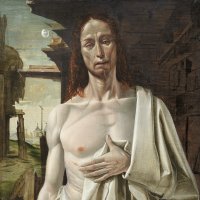The Virgin and Child enthroned with Saints Dominic and Martin, and two angels
This panel of the Virgin and Child is the oldest painting in the Thyssen-Bornemisza collection. Its attribution to the Master of the Magdalen was made by Evelyn Sandberg-Vavalà and Gertrude Coor-Achenbach. However, it was Osvald Sirén who constructed a hypothetical oeuvre for this artist, based around the tempera on panel of The penitent Magdalen and eight Episodes from her Life in the Accademia in Florence. Sirén associated three other works with that panel, to which more recent authors have added another three.
The attribution of the present panel to the Master of the Magdalen has not been questioned but its date has proved more difficult to establish. Various authors, including Coor-Achenbach and Garrison located the painting within the painter’s early phase, around 1270, a date also accepted in the catalogues of the Thyssen-Bornemisza collection. Boskovits, however, proposed the date of around 1290, which is currently accepted for this work and placed it within the artist’s mature period. He also pointed to the evident innovations in the panel, which, despite its archaic style, associate this work with Cimabue’s madonnas.
The Master of the Magdalen seems to have run a well-organised workshop in Florence during the second half of the 13th century. The involvement of assistants in the productions of his panels partly explains the variable quality of these works. His style was initially influenced by the so-called Master of Bigallo while his later output is close to Coppo di Marcovaldo and his final panels, including the present one, reveal the influence of Cimabue. His style was also influenced by Florentine artists such as Meliore and Corso di Buono.
The Virgin depicted in the present work is of the type known as the Hodigitria or “she who shows the way”. Presented as a Virgin in Majesty, she holds the Christ Child in her lap as he blesses with his right hand. Virgins of this type are usually shown standing but here the artist chose to present the figure seated on a throne of which part of the back is visible, as well as the cushion and base. The Virgin and Child are accompanied by two small, praying angels and two saints, identifiable by their respective inscriptions and squeezed into the lower corners of the composition. On the left we see Saint Dominic of Guzmán, founder of the Dominican Order, wearing the Dominican habit and holding his attribute of a closed book. On the right is Saint Martin, here depicted as a bishop with a crozier and mitre.
The frontality of the figures indicates the influence of Byzantine art, as does the hierarchical approach to their relative sizes, the use of a gold background rather than a painted one, and the standard manner of painting elements such as the drapery and folds. However, the gestures of the hands and the gazes convey a sense of animation, despite retaining conventional forms.
Painted with bright, contrasting colours, this Virgin reveals the way the artist outlined the forms and used a brush to define the draperies and folds that tentatively suggest some parts of the figures’ bodies, such as the Virgin’s knees that establish her seated position. These agile brushstrokes construct the facial features as well as the hands, which reveal a particular care in the description of the fingers and knuckles. Boskovits noted the elegant proportions of the Virgin and the simple tonal gradations that give volume to the forms.
This is one of the few paintings in the Museum to have retained its original stuccoed and decorated frame. Of Florentine manufacture, it has been dated to the last quarter of the 13th century and is stylistically close to the frames used by Cimabue and Giotto for their maddonas now in the Uffizi.
Mar Borobia








